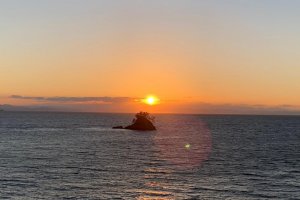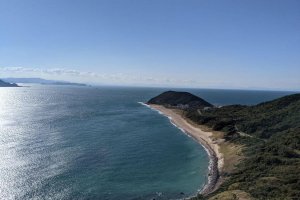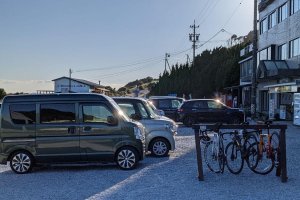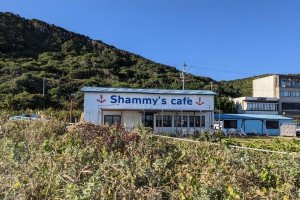Aichi Prefecture is home to Nagoya City, the fourth most populous urban area in Japan. Positioned between the metropolises of Osaka and Tokyo, Aichi is home to Toyota City—one of the industrial powerhouses of Japan. Historically, Aichi has always been a strategic powerbase. It is where the three mighty warlords hailed from, known as the Great Unifiers after a century of civil war, giving rise to the Edo Period (1603–1867). As a center of industry and commerce, Aichi can often be overlooked as a travel destination. However, it is well worth slowing down to explore the rich history and hidden gems and can easily be added to your itinerary if traveling on the Tokaido Shinkansen with a JR Rail Pass.
Day 1: Exploring the Mikawa region
First stop, Toyohashi Station. Starting in the eastern Mikawa area of Aichi, we make our way to Toyokawa Inari. While Kyoto’s Fushimi Inari is well known for the hundreds of vermilion gates and Inari (a harvest god) is normally associated with Shinto shrines, here, Toyokawa Inari is a Zen temple and interprets the story of inari brought forth by the mythical kitsune (fox) as a Buddhist deity. It is believed the foxes' favorite food is inari-zushi, a slightly sweetened pouch of thin, fried tofu stuffed with vinegared rice. Toyokawa is said to be the birthplace of inari-zushi and in the 10-minute walk from JR Toyokawa Station to the gates of Toyokawa Inari, we pass by dozens of vendors selling all varieties of the humble inari-zushi.

Upon entering the sprawling temple grounds, walk up to the magnificent main hall. While founded in the 13th century, the current 91-year-old temple is built from giant zelkova lumber and is a beautiful sight to contemplate.

Foxes become more ubiquitous as you arrive at the cool and quiet spot at the rear of the temple. Under the towering cedar trees, hundreds of red-bibbed stone statues stand in homage to the deity, Inari. The temple offers a meditation hall for zazen (with prior arrangement) and there is shukubo-accommodation onsite too.

Next, we head for Horaiji, a small temple deep in the mountains of Oku-Mikawa.

First, we stop at Kasasugi to enjoy the popular naotora lunch set, a sort of shojin-ryori vegetarian-style food eaten by monks.

Then we are ready to tackle the 1,425 steps up to Horaiji.
Many moons ago, it was here a young couple prayed to be given a child. Their wish was granted with the birth of a son who went on to become Tokugawa Ieyasu, founder and first shogun of the Tokugawa Shogunate. Because of this fortunate event, the temple flourished with inns and vendors as pilgrims came far and wide to pay homage at Horaiji. Today, the old mossy steps winding through ancient cedars allow for a slow and steady ascent to the temple. Even haiku-heavyweight Basho, penned a haiku on his visit to this steep incline.

For the adventurous, from Horaiji Temple continue on the path up the mountain for some incredible views as far as Mikawa Bay. The scenery is something from a timeless scroll of steep cliffs, craggy outcrops, dotted with gnarled matsu pines clinging to the rocks.

The loop-walk brings you back to Horaisan Toshogu Shrine, a homage to the Shogun Tokugawa Ieyasu. The walk can be a bit of a scramble at times, so be sure to wear suitable shoes and take water.
Accommodation spotlight: Hazu Gassho

Hidden in the deep valley upstream from Yuya Onsen is Hazu Gassho. The Gassho-zukuri-style building was made with lumber more than 150 years old and was relocated from Toyama Prefecture 30 years ago. Today, the essence of the original building remains after being transformed into a gorgeous property with modern touches.

The beautifully exposed zelkova and chestnut beams crisscrossing and interlocking without a single nail is something of a marvel. With just five guest rooms, this boutique inn offers an intimate stay where you can relax like you are a feudal lord in your own chamber.

Upon arrival, the open fire in the lounge area is an inviting sanctuary to unwind and take some tea. The property is run by mostly female staff, including the chef; and the softly-spoken Okami-san (traditional manager of a ryokan) will guide you through the building, explaining the onsen (hot spring) and meal arrangements. The rooms are Japanese-style with tatami mats and spacious with high ceilings, all overlooking a private forest and stream.

Two of the rooms offer a hinoki cypress outdoor bathtub on the balcony and the southeasterly aspect is perfect for watching the morning sun through the forest while bathing.

A small path leads down to another two large outdoor onsens.

The main draw is by far the dining experience. We lost track of time as beautifully curated seasonal and local produce were presented. Each dish was explained intricately and included local jibie venison, freshly caught river fish, and produce from neighboring farms. It was two-and-a-half hours later that we emerged happily.

A bath and cup of tea on the balcony were the final acts of relaxation before retiring for the evening.

Breakfast was just as delightful and, while at first seemed overwhelming with the number of dishes, was perfectly balanced to start the day. Good coffee followed and we departed completely recharged for the next adventure.
Day 2: Gamagori and Irago Peninsula
From the mountains to the sea, Aichi presents a lot of diversity. The following day we traveled to Gamagori, a seaside town in Mikawa Bay. Gamagori has long been a popular seaside resort town and is home to a hotel from the prewar Showa era (1926–1945). During the 1930s and early 1940s, fifteen international hotels were developed under the auspices of the Board of Tourist Industry, Japan. Today, the grandfather building overlooks the small island of Takeshima, which lies just 400 meters off the coast.

We took a short walk across the bridge and passed through the torii gate, which is said to be the only example of this kind of shrine entryway in Japan.

It is an easy walk through the Yaotomi Shrine grounds and around the island, a designated natural sanctuary. The clear water looks inviting but is not suitable for swimming due to the shallow tidal waters. From April to June, it is a popular spot for collecting clams, which took us to our lunch spot for the day.
Seida-An is a local eatery in Gamagori that dates back to 1922.

Mr. Matsuyama is the 3rd-generation noodle master and offers a specialty—Gamagori udon. He stands by using local ingredients, down to the flour he uses to make the noodles.
Shiro-miso (white miso) with kishimen udon (a flat-type of udon noodle) topped with many clams was my choice. While the restaurant has since been rebuilt, it has a nostalgic atmosphere with collectibles from the Showa Era (1926-1989). It is popular with locals and visitors hungry for Gamagori udon. Arrive early or after the lunch rush to enjoy this local specialty.

On the other side of Mikawa Bay is the Atsumi Peninsula. A food basket area of hothouses producing tomatoes, melons, and strawberries.

The Atsumi peninsula buffets Mikawa Bay from the Pacific Ocean and the long stretch makes Irago one of Japan’s top surf destinations, hosting many international surfing competitions. Another major event is the Irago Triathlon held in mid-September each year. Starting over 35 years ago, it is one of the longest-running multisport events in Japan. With such a stunning coastline course, you can see why this event continues to be popular.

Cycling is the best way to explore the area and if you are a keen road cyclist, the mellow rolling hills and sea breeze make it a great ride. Irago is on the Japan Eco Track network with providers (cafes, restaurants, and accommodations) that offer bike racks, tools, and air pumps for cyclists along the route.

For a casual bike ride, there are e-bike rentals available at several facilities, including the Irako View Hotel, Irago Crystal Port (Roadside Station), and the Irago terminal of the Ise Bay Ferry. An e-bike makes for an easy ride around the headland of the peninsula, Cape Irago.


Stop by Shammys, a surf shack offering pizzas and great coffee.

We ate fresh-grilled clams at one of the local seaside restaurants and then headed to the ferry terminal that offers services to the nearby Shinojima Island and onward to Morozaki Port, making an easy return to Nagoya City. Or you can take the Isewan Ferry to neighboring Mie Prefecture for easy access to Iseshima.

If seafood is high on your agenda, stopping over at Shinojima Island is a must. It’s accessible via a 30-minute high-speed ferry from Irago.

We arrived late in the afternoon and watched the sunset over Matsushima Island, a silhouette of several hardy pines that have withstood the elements of time on their rocky outcrop.

This tiny island of 1,600 inhabitants at the mouth of Mikawa Bay is renowned for fugu (pufferfish). Prepared by licensed chefs who are responsible for removing the toxic sac from the fugu, this delicacy is the star of the platter. Local fisherman, owner of Atsumiya Marine Park Hotel, fugu chef, and tourism chairman, Mr. Araki delighted us with a full course of sashimi fugu, whitebait, Sea Bream, shrimp, crab, and octopus —just to mention a few. All this bounty of seafood was caught by locals.

The morning sunrise was just as glorious as the sunset. The tiny island can be circumnavigated by foot in an hour or so.

It is well worth taking the loop-track around the southern headland to work up an appetite before tucking into a fisherman’s breakfast. With earthenware from the Jomon Period (10,000BEC-300BEC) having been discovered, Shinojima Island has been inhabited for thousands of years. Due to its fishing heritage, it is closely connected to Ise-Jingu, the Grand Shinto Shrine in Mie Prefecture. Shinojima was chosen to provide the fine Onbe-tai (red sea bream) to the deities of Ise-Jingu. Shinojima’s fishermen of the past developed a technique of using barbed spears to catch red snapper. This technique made them the exclusive provider of red snapper to the gods. In Japanese, tai is a sort of homonym for the word ‘celebrate’ and is associated with special occasions.

For anyone who has visited Ise-Jingu in neighboring Mie Prefecture, it is where the mythical creation of Japan and the origin of Shintoism is centered. In the ceremony called Shikinen Sengu held every 20 years, a part of the Inner Shrine of Ise-Jingu is rebuilt, and the old timber is given to shrines all over Japan. The Shinmei Shrine on Shinojima is a rare case in which the entire building is rebuilt using old timber from Ise-Jingu. And another 20 years later, the old timber from the rebuilding of Shinmei Shrine is re-cut and reused to rebuild Hachioji Shrine on the same island. This shows the deep connection between Shinojima and Ise-Jingu.
Day 3: Last stop—Nagoya City
Nagoya is well known for Nagoya Meshi, which roughly translates as soul food with the likes of tebasaki (deep-fried, spicy chicken wings) and miso-katsu (pork cutlet with miso sauce) to name a few. To take things up a notch, we dined on hitsumabushi.

If you haven’t eaten eel before, the knee-jerk reaction might be: I’ll pass on that, thanks; but be adventurous! This meal of a steaming-hot rice bowl topped with finely sliced grilled eel in a secret sauce opens a new realm of delish. Traditionally, there is an order to eating hitsumabushi: first, eat it as it is; next, add some condiments (green onion, wasabi, seaweed); finally, douse it with broth to finish it off. The serving portion is just right and eel is renowned for its stamina properties, often eaten at the onset of summer to power through the hot months.

We dined at Atsuta Houraiken, established in 1873 during the Meiji era (1868–1912) as a ryotei (traditional Japanese-style restaurant). While an array of options is available, it is best known as the creator of hitsumabushi. The origin story is that eel was typically served toward the end of a full-course meal and patrons were struggling to get through the full bowl of rice and eel. One of the chefs came up with the idea of adding broth and condiments that guests could add as they pleased, making them take their time with the meal so that nothing would go to waste. Today, hitsumabushi stands as an institution unto itself.

To burn off the lunch calories, take a walk around the grounds of Nagoya Castle.
Nagoya Castle, with its giant golden shachi fish adorning the roof, is an icon of the city. Built at the start of the Edo Period (1603-1867), it was one of the largest and most elaborate Japanese castles. Its proximity to the factory that produced fighter planes during World War 2 caused the original castle to be destroyed in an air raid just a few months before the war ended.

Today, the castle reconstruction is a work in progress and one of the most recent additions is the meticulously built Hommaru Palace. While Nijo Palace of Kyoto is beautifully aged and has a very museum feel to it, Nagoya’s Hommaru Palace is a testament to the craftsmanship that still exists today.

Walking through the luminous cedar hallways, you get a sense of what the palace would be like at the time it was used by feudal lords.

Outside in the castle grounds, I met the warlord Toyotomi Hideyoshi looking very youthful at 484 years old. This charismatic chap stayed in character no matter what questions I threw at him. Nagoya Omotenashi Bushotai dispatches one of six warlords associated with Nagoya to Nagoya Castle every day. They take cosplay to the next level and are great entertainers with stories and one-liners from Japan's historic figures of the samurai era. The ninjas do an equally entertaining job too, stealthily appearing from behind the castle walls. On weekends, crowds flock to see their favorite historical character. Photo opportunities aside, it is definitely an interactive and fun way to bring history to life.

For a deeper dive into the history of the Tokugawa family that ruled Japan during the Edo Period (1603–1867), the Tokugawa Art Museum is a must-see. Founded by the Tokugawa family in 1935, it is the most comprehensive collection of artwork and items passed down through the Tokugawa generations. With so many treasures, the displays are constantly changing and the immaculately preserved pieces almost look new, such as the katana that have never had a speck of rust since they were forged hundreds of years ago. The exhibits offer detailed English explanations.
Aichi really is the heart of Japan in terms of historic and economic significance. On your next visit to Japan, take a few days to explore the Oku-Mikawa mountains, Irago coastline, islands, and amazing gourmet experiences on offer.


































The Nagoya City website recently had a notice about the restoration of the castle keep using traditional materials and extant plans. I'm looking forward to seeing the new-old keep.